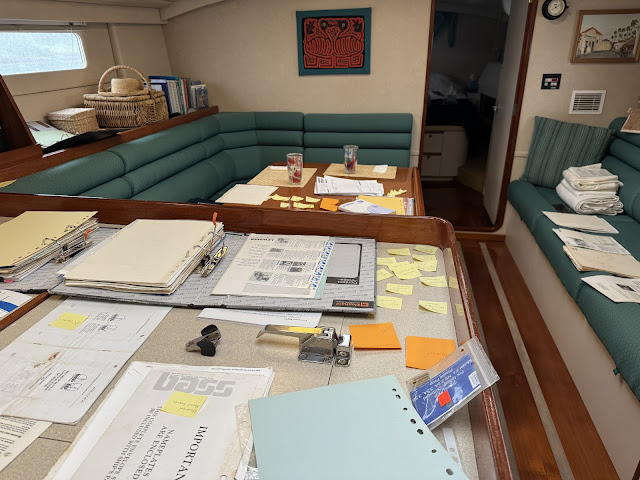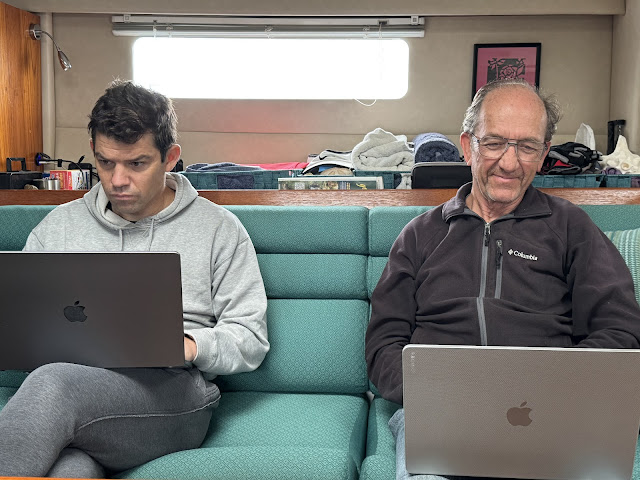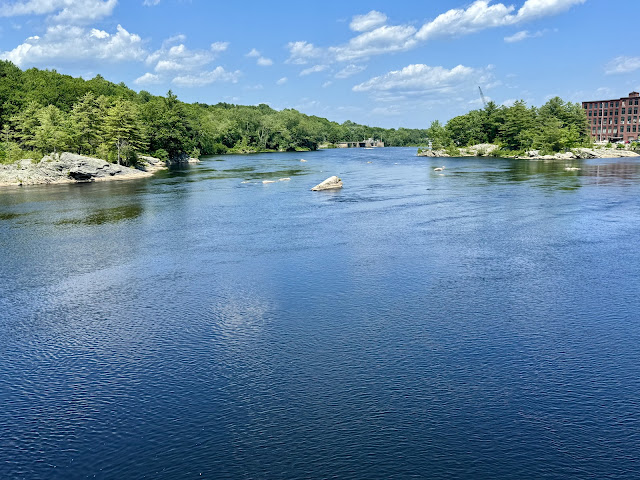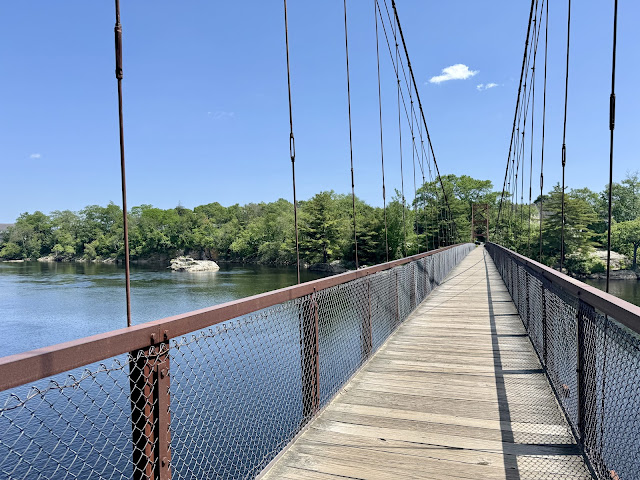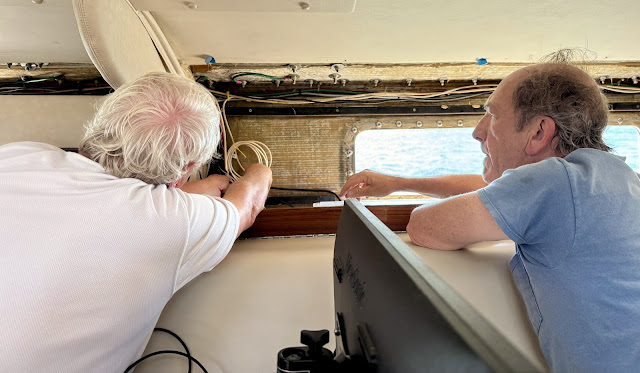When we awoke early--like 6:30!--Wednesday (June 25) in Orrs Cove (Safe Harbor Marina), we found that menhaden were being harvested by the thousands from a small boat quite close to us. The fish had been captured in a seine net and were being hauled up with a net by two men and one of their young sons. Fish can be seen jumping at the surface of the water all day, but we never would have guessed at the abundance. The menhaden are processed into fish meal for animal feed and fish oil rich in Omega-3 fatty acids.
 |
| Fishing for menhaden with a seine net |
 |
| Menhaden being hauled up |
At 8 a.m., we were at the fuel dock to fill the diesel tanks, both of which are now clean of bottom debris, and at 9 a.m., we cast off and headed for Portland with minimal wind and calm seas and reached DiMillo's Marina in three and a half hours. It was so calm that we didn't even need to raise the mainsail for stability.
After lunch, I left Peter and Shalako to their own devices and went into town for some cultural experiences. My first stop with the Maine Historical Society Museum, which had various exhibits. An exhibit called "Notorious" had documents including newspaper clippings and letters as well as descriptions pertaining to famous murder cases in Maine, some quite gruesome, as far back as the 17th century. Another featured black and white photographs of Portland in the 1980s when the waterfront was more active with fishing and lobstering boats. A third displayed quilts, mostly in the log cabin pattern, from the 19th century.
 |
| Log cabin quilt made in 1880 |
 |
| Quilt made of silk and satin fabric |
 |
| Log cabin quilt made in 1870 |
 |
| Log cabin quilt made in 1820 |
The Historical Society owns and operates tours of the Wadsworth-Longfellow House next door. The Wadsworth-Longfellow House was built in 1785–1786 for General Peleg Wadsworth and Elizabeth Bartlett, maternal grandparents of the poet Henry Wadsworth Longfellow (1807-1882). Henry’s younger sister Anne Longfellow Pierce was the last person to live in the house. Widowed at an early age after three years of marriage, Mrs. Pierce lived in the home until her death in 1901. She deliberately kept the house much as it was in Peleg Wadsworth's time. Desiring to preserve it as a memorial to her famous brother and their family, she bequeathed the house and property to the Maine Historical Society.
 |
| The kitchen in the Wadsworth-Longfellow House |
 |
| Draperies, antique furniture and eclectic wallpaper |
 |
| Elegant canopy bed |
 |
| Canopy bed with 18th century quilt |
 |
| Bedroom decor |
The first entirely brick dwelling in Portland, it is the oldest standing brick structure on the Portland peninsula, and the only single-family residence to survive downtown Congress Street’s change from a mixed commercial and residential neighborhood on the edge of town to an urban business district. Originally, it was designed as a two story house in the Federal style of architecture with a gable roof. The Longfellows added today's third story in 1815 to accomodate their large family.
 |
| The lush back garden of the Wadsworth-Longfellow House |
Peleg and Elizabeth raised ten children in the two-story structure with a pitched roof before retiring to the family farm in Hiram, Maine, in 1807. His daughter Zilpah and her husband Stephen Longfellow IV, a lawyer, were married in the house. Their son, Henry Wadsworth Longfellow, the second of eight children, was born nearby at the home of an aunt, Stephen's sister, on February 27, 1807. Young Longfellow did not move with his parents to the Wadsworth-Longfellow House until he was eight months old, but spent the next 35 years there and visited often after that.
After visiting this house, I walked a couple blocks in the Arts District to the Portland Art Museum. The atrium and exhibit rooms are light and airy. The museum's collection includes works by Winslow Homer, Claude Monet, Andrew Wyeth, N.C. Wyeth, Fitz Hugh Lane, Albert Bierstadt, Edward Hopper, Alex Katz, Louise Nevelson, Gilbert Stuart, and John Singer Sergeant. The art of young prize winners using found objects was on display. I particularly liked a colorful sculpture created from discarded fishing gear, plywood, and beach finds, addressing the issue of whale entanglement in fishing equipment.
 |
| "Entangled Rights" |
After my museum time, I walked to Trader Joe's for provisions. While I was visiting museums, Peter and Shalako had shopped at West Marine and filled a propane tank at a U-Haul facility. A man they met and chatted with on the dock gave them a ride to the Back Cove area. In a series of unfortunate but not devastating events, Peter left his cell phone in the man's car, a shopping bag from West Marine was left behind at U-Haul, and the man forgot to pick up fresh oysters as requested by his wife. As a result, he had to return to the docks, and he brought back Peter's phone.
Peter called me to ask that I get the Lyft driver who was picking me up with eight bags of groceries to detour to U-Haul for recovery of his shopping bag. My Lyft driver showed up at 6:50, and U-Haul closed at 7:00, so I quickly asked her if it would be possible to add a stop. The young female driver explained that her English wasn't very good. Once again, my Spanish language study came into use, although we did struggle a little. (She couldn't understand "U-Haul.") We made it in time, but the bag could not be located. Probably some street people had found it.
After I put the cold food in the refrigerator, Peter, Shalako and I left the boat to have dinner out. The weather was balmy and many people, particularly young people, were out for the evening. We were the last customers at a restaurant Peter had picked, Crunchy Poke. I loved my build-your-own poke bowl with lettuce instead of rice. Peter and Shalako both ordered dishes with spicy tuna, and they had underestimated how spicy it might be. They drank a lot of water.
When we left the restaurant as the Japanese-speaking owners were cleaning up for the day, we heard some excellent music coming from around the corner. We followed our ears to the jazzy sound and then sat down and enjoyed a few numbers by a band composed of a violinist, a guitarist and a drummer. Before returning to the boat, we stopped for ice cream. It was so rich, I wished I had abstained. And we all agreed that we have not found any ice cream comparable to that from Scottish Highlands Creamery in Oxford, Maryland.
 |
| Street musicians in Historic Portland |
We went straight to bed upon returning to the boat. I was feeling exhausted, so I asked not to be awaken in the morning. I got up around 8:30 yesterday morning, ready to make omelettes only to find that Shalako and Peter were enjoying bowls of cereal in the pilot house. We sat and enjoyed the nice weather. At one point, Shalako asked me for the time. I told him it was 9:30. He laughed and said to stop joking, as that was the time his Uber was due to take him to the airport. I showed him my phone and a moment or two later he received an alert that the driver was waiting. Accompanied by Peter, Shalako made a mad dash for the street.
We really enjoyed having him on board. He is a hard-working, quick-learning, reliable crew member and just a delightful person to spend time with. He will be joining us again this summer.
After Shalako's departure, Peter went off to West Marine for a few more supplies, and I walked to the Portland Food Co-Op nearby for a few more provisions. On the way, I stopped to appreciate some of the old brick architecture and charm of the cobblestone streets.
 |
| A late 19th century red-brick building |
 |
| Boothby Square |
 |
| Another late 19th century red-brick building |
At noon, we cast off in calm conditions and headed away from the hustle and bustle of the small city. We tried anchoring off the northern shore of Great Diamond Island but weren't satisfied with the swing room. We could see that the small island just north of it, Cow Island, had larger mooring balls off the NW shore. A great thing about Maine is that you can pick up private mooring balls if they are not being used. We selected an outer one and settled in. Except for occasional wakes from passing boats, it is quite peaceful here, and the gorgeous colors of the sunset last night took at least half an hour to go through changing stages.
 |
| The sun setting |
 |
| The last of the sunset |
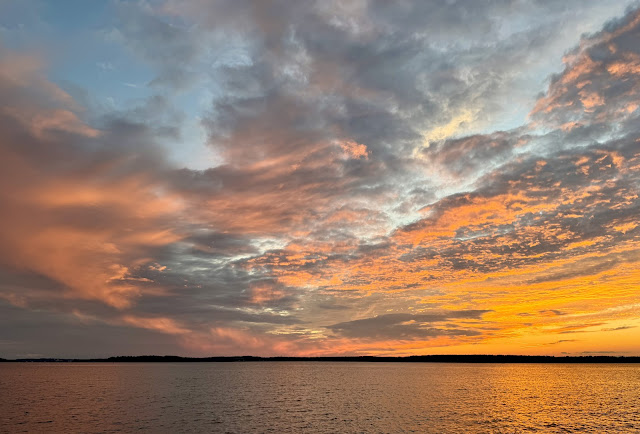 |
| A few minutes after the sun set |
 |
| The colors becoming pale |
Only one of the dozen mooring balls had a boat on it, but, when the sun was still above the horizon, a sailboat came gliding in and, wouldn't you know it, we had taken its mooring. They waited for us to cast off and suggested the next ball south, where we remain now.
It has been a sunny day with temperatures in the 60s. We have busy doing various jobs. Peter has worked on electrical stuff and puzzled about why the middle bilge pump stopped operating a couple days ago. I did a load of laundry, organized the pantry and the two parts of the refrigerator so that I can more easily find things in the deep recesses, and sewed chafe covers on the blocks for the running back stays. Just before noon, Peter hailed a small pleasure boat picking up lobsters nearby. On board was a dad, his two daughters and two of their friends. Going out lobstering is a type of Maine play date, he told us. Peter asked if he could buy a lobster. The man told us that, unfortunately, we could not because he was renting the pots and the deal was he could only give them away to family and friends. He deemed us friendly, though, and gave one to Peter. In exchange, I gave the four girls necklaces with sea-themed charms, which delighted them.
 |
| Four girls with their necklaces |
 |
| The dad thanking us for the trade |
Peter steamed his lobster in his smoker. We don't have a pot large enough for boiling lobster. He enjoyed it with butter and a side of garlic bread. I had a quesadilla--anything cheesy works for me.
 |
| Peter's lobster |
 |
| Peter ready to eat his lobster |
And now for the Maine coast weather synopsis: The weather cycles through two or three days of sunshine and relative warmth (with the freak heat wave a couple days ago) when we can wear shorts and t-shirts (or even a swimsuit during the middle of the day) and open the hatches; then it becomes overcast and chilly, when we are back to long pants, long-sleeve shirts and fleece jackets, all the hatches are closed, the heat gets turned on intermittently, and we cover ourselves with a summer weight quilt and one or two fleece blankets in bed. One night even called for a hot water bottle! And it changes quickly. Two nights ago I wore a summer nightshirt (the only time so far) and the hatches were open, and the next night I was back to flannel, snuggled under three covers after we used the heat to take the chill out of the air down below. Rain is predicted for tomorrow with a temperature on land of 63 degrees (It is cooler on the water.) and by mid-week, the temperature will be in the mid-70s, which is the average high. I don't think I have been anyplace where winter and summer clothes are needed each week.
